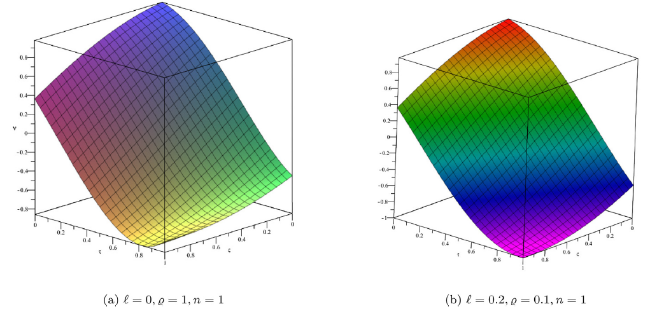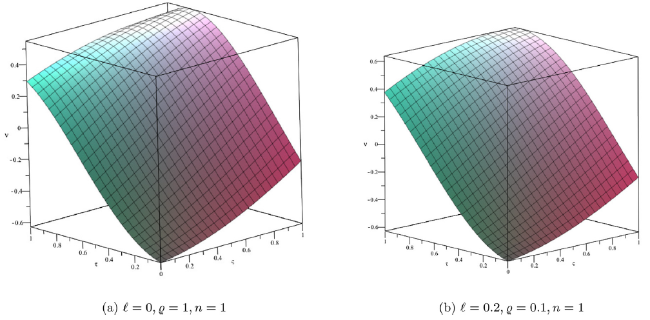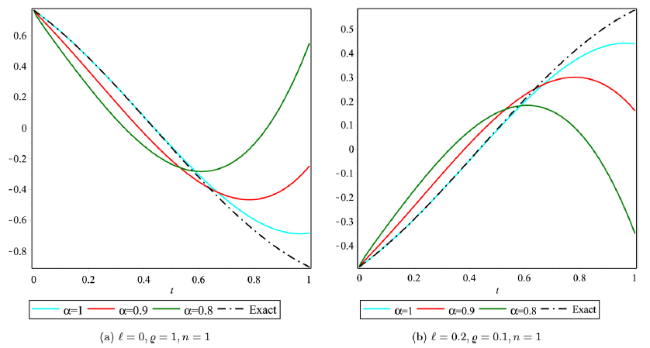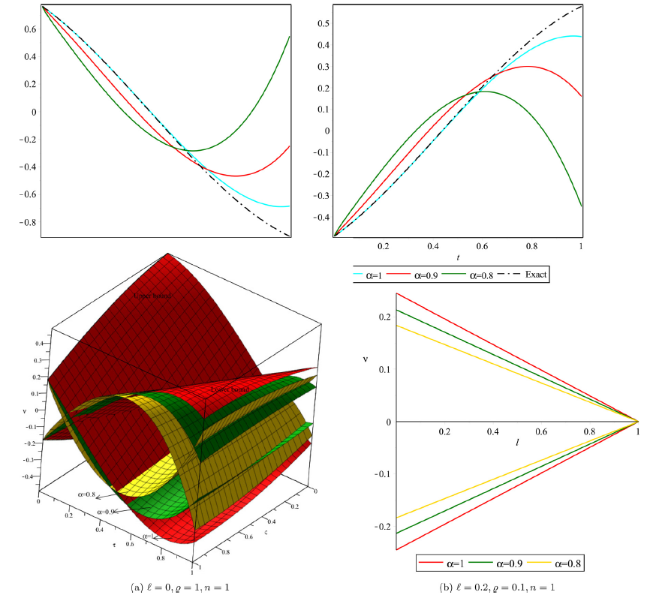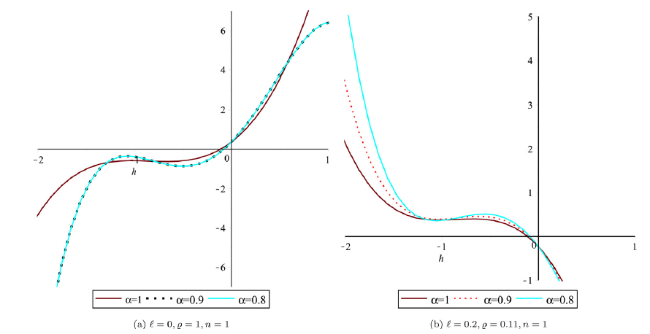1. Introduction
2. Mathematical preliminaries
3. A method based on theory q-HAShTM
4. Convergence analysis of fuzzy fractional q-HAShTM
Fig. 1. Surface solution of approximate and exact with DP approach for Example 1. |
5. Numerical results and discussion
Table 1. Comparision of exact and approximate solution of q-FHAShTM for distinct values of τ, ς and with fixed parameters, i.e., ℓ=0 and ϱ=1 of Example 1. |
| q-FHAShTM | |||||
|---|---|---|---|---|---|
| ς | τ | 2nd−termApp | 1st−termApp | Exact | Error |
| 0.01 | 2.040000000 | 2.040800000 | 2.040816327 | 0.000016327 | |
| 0.02 | 2.080000000 | 2.083200000 | 2.083333333 | 0.000133333 | |
| 0.5 | 0.03 | 2.120000000 | 2.127200000 | 2.127659574 | 0.000459574 |
| 0.04 | 2.160000000 | 2.172800000 | 2.173913043 | 0.001113043 | |
| 0.05 | 2.200000000 | 2.220000000 | 2.222222222 | 0.002222222 | |
| 0.01 | 1.010000000 | 1.010100000 | 1.010101010 | 0.000001010 | |
| 0.02 | 1.020000000 | 1.020400000 | 1.020408163 | 0.000008163 | |
| 1.0 | 0.03 | 1.030000000 | 1.030900000 | 1.030927835 | 0.000027835 |
| 0.04 | 1.040000000 | 1.041600000 | 1.041666667 | 0.000066667 | |
| 0.05 | 1.050000000 | 1.052500000 | 1.052631579 | 0.000131579 |
Fig. 2. Lower and upper bound surface solution with distinct values of α for Example 1. |
Fig. 3. Lower and upper bound surface solution with distinct values of α for Example 1. |
Fig. 4. Lower and upper bound solution profile with distinct values of α for Example 2. |
Fig. 5. Approximate and exact solution profile in crisp case for Example 2. |
Fig. 6. Approximate and exact solution profile in uncertain case for Example 2. |
Fig. 7. Solution profile for distinct values of α in crisp and uncertain case for Example 2. |
Fig. 8. Solution behaviour for distinct values of α in crisp and uncertain case for Example 2. |
Fig. 9. Solution behaviour for distinct values of α in lower and upper bound for Example 2. |
Fig. 10. Solution behaviour for distinct values of α in lower and upper bound for Example 2. |
Table 2. Comparision of exact and approximate solution of q-FHAShTM for distinct values of τ and ς and fixed parameters i.e. ℓ=0,ϱ=1 Example 2. |
| q-FHAShTM | ||||||||
|---|---|---|---|---|---|---|---|---|
| ς | τ | 1st-term | 2nd-term | 3rd-term | 4th-term | Exact | Error | Error |
| App. | App. | App. | App. | q-FHAShTM | HPTM [46] | |||
| 0.01 | 1.632234058 | 1.632316494 | 1.632316219 | 1.632316220 | 1.632316220 | 0.0 | 0.0 | |
| 0.02 | 1.615746846 | 1.616076590 | 1.616074392 | 1.616074403 | 1.616074402 | 1×10−9 | 1×10−9 | |
| 0.5 | 0.03 | 1.599259633 | 1.600001558 | 1.599994139 | 1.599994195 | 1.599994193 | 2×10−9 | 2×10−9 |
| 0.04 | 1.582772420 | 1.584091397 | 1.584073811 | 1.584073987 | 1.584073985 | 2×10−9 | 3×10−9 | |
| 0.05 | 1.566285207 | 1.568346109 | 1.568311761 | 1.568312190 | 1.568312185 | 5×10−9 | 2×10−9 | |
| 0.01 | 2.691234472 | 2.691234924 | 2.691234471 | 2.691234472 | 2.691234472 | 0.0 | 0.0 | |
| 0.02 | 2.664456242 | 2.664459847 | 2.664456223 | 2.664456241 | 2.664456242 | 1×10−9 | 2×10−9 | |
| 1.0 | 0.03 | 2.637944459 | 2.637956600 | 2.637944368 | 2.637944460 | 2.637944459 | 1×10−9 | 1×10−9 |
| 0.04 | 2.611696473 | 2.611725180 | 2.611696185 | 2.611696475 | 2.611696473 | 2×10−9 | 2×10−9 | |
| 0.05 | 2.585709659 | 2.585765589 | 2.585708958 | 2.585709666 | 2.585709659 | 7×10−9 | 6×10−9 |
Table 3. Comparision of exact and approximate solution of q-FHAShTM for distinct values of τ and ς and fixed parameters i.e ℓ=0.2,ϱ=0.1 (uncertain case, i.e, ℓ,ς≠0,1) of Example 2. |
| q-FHAShTM | |||||||
|---|---|---|---|---|---|---|---|
| τ | 1st-term | 2nd-term | 3rd-term | 4th-term | Exact | Error | |
| App. | App. | App. | App. | q-FHAShTM | |||
| 0.01 | -1.044629797 | -1.044682556 | -1.044682380 | -1.044682380 | -1.044682381 | 1×10−9 | |
| 0.02 | -1.034077981 | -1.034289017 | -1.034287610 | -1.034287617 | -1.034287617 | 0.0 | |
| 0.5 | 0.03 | -1.023526165 | -1.024000997 | -1.023996249 | -1.023996285 | -1.023996284 | 1×10−9 |
| 0.04 | -1.012974348 | -1.013818493 | -1.013807238 | -1.013807351 | -1.013807350 | 1×10−9 | |
| 0.05 | -1.002422532 | -1.003741509 | -1.003719526 | -1.003719801 | -1.003719798 | 3×10−9 | |
| 0.01 | -1.722303366 | -1.722390351 | -1.722390061 | -1.722390062 | -1.722390062 | 0.0 | |
| 0.02 | -1.704906363 | -1.705254303 | -1.705251983 | -1.705251995 | -1.705251995 | 0.0 | |
| 1.0 | 0.03 | -1.687509359 | -1.688292224 | -1.688284395 | -1.688284454 | -1.688284454 | 0.0 |
| 0.04 | -1.670112355 | -1.671504115 | -1.671485558 | -1.671485744 | -1.671485743 | 1×10−9 | |
| 0.05 | -1.652715352 | -1.654889977 | -1.654853733 | -1.654854186 | -1.654854182 | 4×10−9 |
Table 4. Comparision of exact and approximate solution of q-FHAShTM for different values of τ and ς and fixed parameters, i.e., ℓ=0,ϱ=1 of Example 3. |
| q-FHAShTM | ||||||||
|---|---|---|---|---|---|---|---|---|
| ς | τ | 1st-term | 2nd-term | 3rd-term | 4th-term | Exact | Error | Error |
| App. | App. | App. | App. | q-FHAShTM | LADM [41] | |||
| 0.01 | 0.4706497130 | 0.4706257417 | 0.4706258880 | 0.4706258882 | 0.4706258882 | 0.0 | 1.0×10−10 | |
| 0.02 | 0.4618738874 | 0.4617780023 | 0.4617791724 | 0.4617791756 | 0.4617791755 | 1.0×10−10 | 1.0×10−9 | |
| 0.5 | 0.03 | 0.4530980617 | 0.4528823202 | 0.4528862693 | 0.4528862855 | 0.4528862854 | 1.0×10−10 | 1.0×10−9 |
| 0.04 | 0.4443222361 | 0.4439386957 | 0.4439480566 | 0.4439481077 | 0.4439481070 | 7.0×10−10 | 4.0×10−9 | |
| 0.05 | 0.4355464105 | 0.4349471286 | 0.4349654116 | 0.4349655365 | 0.4349655341 | 2.4×10−9 | 3.2×10−9 | |
| 0.01 | 0.8360679617 | 0.8360258882 | 0.8360259783 | 0.8360259787 | 0.8360259786 | 1.0×10−10 | 2.0×10−9 | |
| 0.02 | 0.8306649387 | 0.8304966445 | 0.8304973649 | 0.8304973705 | 0.8304973705 | 0.0 | 1.0×10−10 | |
| 1.0 | 0.03 | 0.8252619156 | 0.8248832537 | 0.8248856851 | 0.8248857135 | 0.8248857133 | 2.0×10−10 | 1.0×10−9 |
| 0.04 | 0.8198588926 | 0.8191857158 | 0.8191914790 | 0.8191915688 | 0.8191915683 | 5.0×10−10 | 1.0×10−9 | |
| 0.05 | 0.8144558695 | 0.8134040308 | 0.8134152871 | 0.8134155062 | 0.8134155048 | 1.4×10−9 | 1.2×10−9 |
Table 5. Comparision of exact and approximate solution of q-FHAShTM for distinct values of τ and ς and fixed parameters i.e. ℓ=0.2,ϱ=0.1 (uncetain case, i.e, ℓ,ς≠0,1) of Example 3. |
| q-FHAShTM | |||||||
|---|---|---|---|---|---|---|---|
| ς | τ | 1st-term | 2nd-term | 3rd-term | 4th-term | Exact | Error |
| App. | App. | App. | App. | q-FHAShTM | |||
| 0.01 | -0.3012158163 | -0.3012004747 | -0.3012005683 | -0.3012005684 | -0.301200568 | 0.0 | |
| 0.02 | -0.2955992879 | -0.2955379214 | -0.2955386703 | -0.2955386723 | -0.295538672 | 0.0 | |
| 0.5 | 0.03 | -0.2899827595 | -0.2898446849 | -0.2898472123 | -0.2898472227 | -0.289847222 | 0.0 |
| 0.04 | -0.2843662311 | -0.2841207652 | -0.2841267562 | -0.2841267889 | -0.284126788 | 4.0×10−10 | |
| 0.05 | -0.2787497027 | -0.2783661623 | -0.2783778634 | -0.2783779433 | -0.278377941 | 1.5×10−9 | |
| 0.01 | -0.5350834955 | -0.5350565684 | -0.5350566260 | -0.5350566262 | -0.535056626 | 1.0×10−10 | |
| 0.02 | -0.5316255608 | -0.5315178525 | -0.5315183136 | -0.5315183172 | -0.531518317 | 1.0×10−10 | |
| 1.0 | 0.03 | -0.5281676260 | -0.5279252824 | -0.5279268385 | -0.5279268567 | -0.527926856 | 2.0×10−10 |
| 0.04 | -0.5247096913 | - 0.5242788582 | -0.5242825467 | -0.5242826041 | -0.524282603 | 4.0×10−10 | |
| 0.05 | -0.5212517565 | -0.5205785797 | -0.5205857837 | - 0.5205859239 | -0.520585923 | 8.0×10−10 |
Fig. 11. Approximate and exact solution profile in crisp case for Example 3. |
Fig. 12. Approximate and exact solution profile in uncertain case for Example 3. |
Fig. 13. Solution profile of distinct values of α in crisp and uncertain case for Example 3. |
Fig. 14. Solution behavior for distinct values of α in crisp and uncertain case for Example 3. |
Fig. 15. Solution behaviour of distinct values of α in lower and upper bound for Example 3. |
Fig. 16. Solution behaviour for distinct values of α in lower and upper bound for Example 3. |
Fig. 17. Solution profile of distinct values of α in crisp case for Example 4. |
Table 6. Comparision of exact and approximate solution of q-FHAShTM for distinct values of τ andς1 and fixed parameters i.e ς2=0.2,ℓ=0,ϱ=1(crisp case, i.e, ℓ,ς=0,1) of Example 4. |
| q-FHAShTM | |||||||
|---|---|---|---|---|---|---|---|
| τ | 1st-term | 2nd-term | 3rd-term | 4th-term | Exact | Error | |
| App. | App. | App. | App. | ||||
| 0.01 | 0.7519578336 | 0.7518048652 | 0.7518057242 | 0.7518057293 | 0.7518057291 | 2.00×10−10 | |
| 0.02 | 0.7390734798 | 0.7384616061 | 0.7384684778 | 0.7384685594 | 0.7384685587 | 7.00×10−10 | |
| 0.5 | 0.03 | 0.7261891261 | 0.7248124102 | 0.7248356020 | 0.7248360150 | 0.7248360107 | 4.30×10−9 |
| 0.04 | 0.7133047723 | 0.7108572773 | 0.7109122505 | 0.7109135558 | 0.7109135380 | 1.78×10−9 | |
| 0.05 | 0.7004204186 | 0.6965962077 | 0.6967035773 | 0.6967067641 | 0.6967067093 | 5.48×10−9 | |
| 0.01 | 0.3437169728 | 0.3436445012 | 0.3436457439 | 0.3436457463 | 0.3436457463 | 0.000000000 | |
| 0.02 | 0.3250761911 | 0.3247863049 | 0.3247962467 | 0.3247962854 | 0.3247962844 | 1.00×10−9 | |
| 1.0 | 0.03 | 0.3064354093 | 0.3057831653 | 0.3058167187 | 0.3058169144 | 0.3058169084 | 6.00×10−9 |
| 0.04 | 0.2877946276 | 0.2866350828 | 0.3058167187 | 0.2867152352 | 0.2867152096 | 2.56×10−8 | |
| 0.05 | 0.2691538459 | 0.2673420571 | 0.2674973969 | 0.2674989067 | 0.2674988286 | 7.81×10−8 |
Table 7. Comparison of exact and approximate solution of q-FHAShTM for distinct values of τ and ς1 and fixed parameters, i.e., ς2=0.2,ℓ=0.2,ϱ=0.1(uncertain case, i.e, ℓ,ς≠0,1) of Example 4. |
| q-FHAShTM | |||||||
|---|---|---|---|---|---|---|---|
| τ | 1st-term | 2nd-term | 3rd-term | 4th-term | Exact | Error | |
| App. | App. | App. | App. | ||||
| 0.01 | -0.4812530135 | -0.4811551137 | -0.4811556634 | -0.4811556667 | -0.4811556666 | 2.00×10−10 | |
| 0.02 | -0.4730070271 | -0.4726154279 | -0.4726198258 | -0.4726198780 | -0.4726198776 | 7.00×10−10 | |
| 0.5 | 0.03 | -0.4647610407 | -0.4638799425 | -0.4638947853 | -0.4638950496 | -0.4638950468 | 4.30×10−9 |
| 0.04 | -0.4565150543 | -0.4549486575 | -0.4549838404 | -0.4549846758 | -0.4549846643 | 1.78×10−9 | |
| 0.05 | -0.4482690679 | -0.4458215729 | -0.4458902895 | -0.4458923291 | -0.4458922940 | 5.48×10−9 | |
| 0.01 | -0.2199788626 | -0.2199324808 | -0.2199332761 | -0.2199332776 | -0.2199332776 | 1.00×10−10 | |
| 0.02 | -0.2080487623 | -0.2078632351 | -0.2078695978 | -0.2078696225 | -0.2078696220 | 4.00×10−10 | |
| 1.0 | 0.03 | -0.1961186620 | -0.1957012259 | -0.1957227001 | -0.1957228253 | -0.1957228214 | 2.80×10−9 |
| 0.04 | -0.1841885617 | -0.1834464530 | -0.1834973548 | -0.1834977506 | -0.1834977341 | 1.15×10−8 | |
| 0.05 | -0.1722584614 | -0.1710989166 | -0.1711983341 | -0.1711993004 | -0.1711992503 | 3.51×10−8 |
Fig. 18. Solution profile of distinct values of α in uncertain case for Example 4. |
Fig. 19. Solution profile for distinct values of α in crisp and uncertain case for Example 4. |
Fig. 20. Solution behaviour for distinct values of α in crisp and uncertain case for Example 4. |
Fig. 21. Solution behaviour for distinct values of α in lower and upper bound for Example 4. |
Fig. 22. Solution behaviour for distinct values of α in lower and upper bound for Example 4. |


















